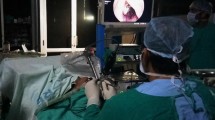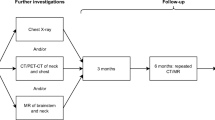Abstract
Benign vocal fold lesions (BVFL) frequently affect the general population and cause significant hoarseness by interfering with daily communication. Healthcare for low income groups in India is all about affordability and availability without giving up on quality and providing maximum satisfaction. (1) To analyse over a period of 4 years, the demographics, clinical profile, diagnostics and management options of BVFL. (2) To assess the diagnostic potential of rigid laryngoscopy in diagnosing these lesions. (3) Cold knife endolaryngeal surgery as a cost effective, satisfactory and efficient treatment modality to tackle majority of these BVFL. A prospective cross sectional study over a period of 4 years from 2013 to 2017. 114 patients presenting with hoarseness of voice were evaluated by indirect laryngoscopy followed by video laryngoscopy and stroboscopy in the department of ENT, MYH Hospital Indore (M.P.). Male:female ratio of 1.59:1 with male predominance (61.4%) and maximum incidence in the third decade (32%). All cases presented with hoarseness (100%) while vocal fatigue (63%) was the most common associated complaint followed by foreign body sensation (60%). Housewives (32%) were most commonly involved non professional group while teachers (13%) constituted the most common group of professionals. Laryngitis (26%) involving bilateral vocal folds diffusely was the most common finding followed by vocal fold sulcus (18%) and vocal fold cysts (14%). The duration of symptom was 6 months to 1 year in 52% patients. The positive predictive value for rigid laryngoscopy was 100% for vocal nodules, arytenoid granulomas and anterior glottis web. Out of 114 patients, 66 patients improved on conservative management while 48 patients underwent cold knife endolaryngeal surgery. As per the GRBAS scale to assess the post therapeutic prognosis, all had good outcome of voice with only two recurrences due to patient non compliance. In this rapidly evolving era of sophisticated lasers which is a costly affair that requires skilled personnel and safety precautions, the prime goal in a government run setup has always been to provide affordable and quality healthcare to the common man. Cold knife endolaryngeal surgery is a simple, cost effective and efficient way to tackle most of these lesions and hence helps in achieving this goal.


Similar content being viewed by others
References
Schwartz SR et al (2009) Clinical practice guideline: hoarseness (dysphonia). Otolaryngol Head Neck Surg 141(3 Suppl 2):S1–S31
Brodnitz FS (1963) Goals, results and limitations of vocal rehabilation. Arch Otolaryngol 77:148–156
Maran AGD (1982) Voice problems, logan turners diseases of ENT. Laryngology 1:372
Bastian Robert W (2005) Benign vocal fold mucosal disorders Cummings otolaryngology head and neck surgery, vol 3, 4th edn. Mosby Elsevier, Philadelphia, p 2150
Kleinsasser O (1982) Pathogenesis of vocal cord polyps. Otol Rhinol Laryngol 91:378–381
Muniraju M, Vidya H (2017) Clinical study of benign lesions of larynx. Int J Med Res Rev 5(03):229–234. https://doi.org/10.17511/ijmrr.2017.i03.03
Siddapur GK et al (2015) Comparative study of benign vocal fold lesions in a tertiary health centre. Int J Otorhinolaryngol Head Neck Surg 1(2):65–68
Saha PP et al (2017) A clinicopathological study of benign lesions of the vocal fold. IOSR J Dent Med Sci 16:09–12
Buche RA, Garud SH, Jaiswal SA, Chamania GA (2016) Benign lesions of larynx—a clinicopathological study. IOSR J Dent Med Sci 15:09–17. https://doi.org/10.9790/0853-1509010917
Singhal P, Bhandari A, Chouhan M, Sharma MP, Sharma S (2009) Benign tumors of the larynx: a clinical study of 50 cases. IJLO 61(1):26–30
Chopra H, Kapoor M (1997) Study of benign glottic lesions undergoing microlaryngeal surgery. Indian J Otolaryngol Head Neck Surg 49:276–279
Harding SM, Richter JE (1997) The role of gastroesophageal reflux in chronic cough and asthma. Chest 111:1389–1402
Koufman JA (1991) The otolaryngologic manifestations of gastroesophageal reflux disease. Laryngoscope 101(Suppl. 53):1–78
Parikh N (1991) Aetiology study of 100 cases of hoarseness of voice. Indian J Otolaryngol Head Neck Surg 43(2):71–73
Banjara H, Varsha M, Singh D, Gupta A (2011) Hoarseness of voice: a retrospective study of 251 cases. Int J Phonosurg Laryngol 1(1):21–27
Wani AA, Rehman A, Hamid S, Akhter M, Baseena S (2012) Benign mucosal fold lesion as a cause of hoarseness of voice—a clinical study. Otolaryngology 2:120. https://doi.org/10.4172/2161-119X.1000120
Batra K, Motwani G, Sagar PC (2004) Functional voice disorders and their occurrence in 100 patients of hoarseness as seen on fibreoptic laryngoscopy. Indian J Otolaryngol Head Neck Surg 56(2):91–95
Saudi S (2013) Benign lesions of the vocal cards in different ages: prospective study of 60 cases. J Med Sci Technol 2(3):130–134
Soni HD, Gandhi S, Goyal M, Shah U (2016) Study of clinical profile of benign laryngeal lesions. Int J Med Sci Public Health 5:656–660
Baitha S, Raizada RM, Kennedy AK, Puttewar MP, Chaturvedi VN (2004) Predisposing factors and etiology of hoarseness of voice. Indian J Otolaryngol Head Neck Surg 56(3):186–190
Barry DW, Vaezi MF (2010) Laryngopharyngeal reflux: more questions than answers. Cleve Clin J Med 77:327–334
Satheesh S, Yamuna R, Premnath N (2015) Videolaryngoscopic surgey in benign laryngeal lesions-our experience. J Evid Based Med Healthc 2(48):8364–8367. https://doi.org/10.18410/jebmh/2015/1137
Sharma M, Kumar S, Goel M, Angral S, Kapoor MA (2015) Clinical study of benign lesions of larynx. Int J Oral Health Med Res 2(2):22–28
Epstein S, Winston P, Friedmann I, Ormerod FC (1957) The vocal cord polyp. J Laryngol 71:673–688
Nerurkar N, Garg S (2011) Correlation between rigid laryngoscopy and histopathology of laryngeal lesions at our voice clinic. Int J Phonosurg Laryngol 1:29–31. https://doi.org/10.5005/jp-journals-10023-1007
Doloi PK, Khanna SA (2011) Study of management of benign lesions of larynx. Int J Phonosurg Laryngol 1(2):61–64
Phaniendra Kumar V, Srinivasa Murthy M, Ravikanth S, Kumar R (2003) Phonomicrosurgery for benign vocal fold lesions—our experience. Indian J Otolaryngol Head Neck Surg 55(3):184–186. https://doi.org/10.1007/bf02991949
Author information
Authors and Affiliations
Corresponding author
Ethics declarations
Conflict of interest
The authors declare that they have no conflict of interest.
Ethical Approval
All procedures performed in studies involving human participants were in accordance with the ethical standards of the institutional and/or national research committee and with the 1964 Helsinki declaration and its later amendments or comparable ethical standards.
Human and Animal Rights
This article does not contain any studies with animals performed by any of the authors.
Informed Consent
Informed consent was obtained from all individual participants included in the study.
Rights and permissions
About this article
Cite this article
Upadhyay, A., Zaidi, A.K. & Mundra, R.K. A Comprehensive Analysis of Benign Vocal Fold Lesions Causing Hoarseness of Voice and Our Experience with Cold Knife Endolaryngeal Surgery in a Tertiary Healthcare Centre. Indian J Otolaryngol Head Neck Surg 71 (Suppl 1), 515–521 (2019). https://doi.org/10.1007/s12070-018-1377-5
Received:
Accepted:
Published:
Issue Date:
DOI: https://doi.org/10.1007/s12070-018-1377-5




